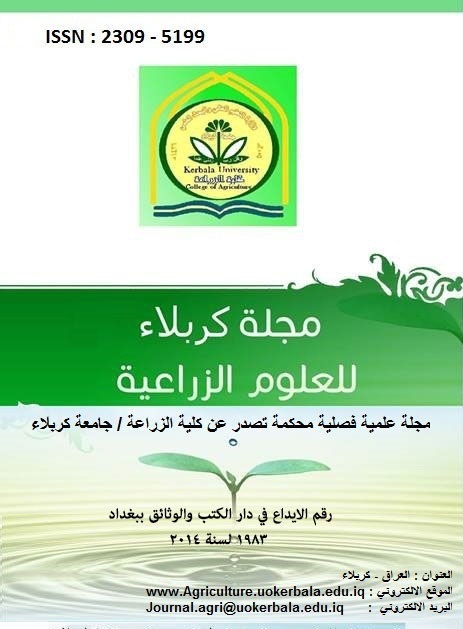Predict of field emergence for several plant species through some la-boratory germination tests
S. H. Cheyed1 N. J. Mohammed2 J, H. Hamza1
DOI:
https://doi.org/10.59658/jkas.v4i1.85Keywords:
البزوغ الحقلي و فحوص حيوية وقوة البذرة و الذرة الصفراء و الذرة البيضاء و زهرة الشمس و العصفرAbstract
The wide range of genetic and environmental variations in which plant species grow, makes predicting its field emergence extremely complex matter. Therefore this study aimed to predict field emergence through laboratory germination tests for two cultivars of each of maize (Baghdad-3 and Fejir), sorghum (Jiza-113, Inqath), sunflower (Akmar and shomoos) and safflower (Urduni and Al-mays). A laboratory and field experiment was carried out with one factor which is laboratory germination tests (standard germination test, cold test and accelerate age test) as well as the field emergence in the fall season of 2015 of species above in the laboratories of department of seed certification and testing, the Public Authority for Agricultural Research and fields of Field Crops Department, College of Agriculture, University of Baghdad. Analysis of variance was carried out according to the design of randomized complete block with eight replications for each variety separately, and the treatments average were compared with the least significant difference test (p value = 0.05). In general, results of variance analysis showed significant differences for influence of laboratory germination methods and field emergence in the percentage of normal seedling, but there were no significant differences also between the field emergence and among some of those methods, which refers to the possibility of predicting field emergence through it, since there was no significant difference between the percentage of normal seedling of field emergence and its percentage in each one of accelerate age test for maize seed both cultivars Baghdad-3 and Fajir, its percentage in standard laboratory germination test and accelerate age test for sunflower seed both Akmar and shomoos, and its percentage in accelerate age test for safflower seed Al-mays variety. There was also a significant difference between the percentage of normal seedling of field emergence and its percentage in each of other tests of sorghum seeds both cultivars (Giza-113 and Inqath) and safflower seed Urduni variety, which indicates unpredictability field emergence for it through those tests. We conclude that the seed tests vary in their ability to predict the field emergence according to differences of species and its varieties. And accelerate age test often resemble the field emergence and can promise as one of the indicators that can be used to predict the field emergence of those varieties that are planted in fall seasons.
Downloads
Published
How to Cite
Issue
Section
License
Copyright (c) 2017 Journal of Kerbala for Agricultural Sciences

This work is licensed under a Creative Commons Attribution 4.0 International License.
Licensing Terms
All articles are published under a Creative Commons License and will be directed to the Creative Commons Attribution 4.0 International License That permits use, distribution, and reproduction in any medium, provided the original work is properly cited and is not used for commercial purposes.
Use by non-commercial users
For non-commercial and non-promotional purposes individual users may access, download, copy, display, and redistribute the articles to colleagues, as well as adapt, translate, text- and data-mine the content subject to the following conditions:
- The author's moral rights are not compromised. These rights include the right of "paternity" (also known as "attribution" - the right for the author to be identified as such) and "integrity" (the right for the author not to have the work altered in such a way that the author's reputation, or integrity may be impugned).
- Where content in the article is identified as belonging to a third party, it is the obligation of the user to ensure that any reuse complies with the copyright policies of the owner of that content.
- If article content is copied, downloaded, or otherwise reused for non-commercial research and education purposes, a link to the appropriate bibliographic citation (authors, journal, article title, volume, issue, page numbers, DOI, and the link to the definitive published version on JKAS website) should be maintained.
- Copyright notices and disclaimers must not be deleted.
- Any translations, for which a prior translation agreement with JKAS has not been agreed, must prominently display the statement: "This is an unofficial translation of an article that appeared in an FSP publication. The publisher has not endorsed this translation."
Use by commercial "for-profit" organizations
Use of JKAS Open Access articles for commercial, promotional, or marketing purposes requires further explicit permission from JKAS (journal.agri@uokerbala.edu.iq) and will be subject to a fee.
The commercial purposes include:
Copying or downloading of articles, or linking to such articles for further redistribution, sale, or licensing; Copying, downloading, or posting by a site or service that incorporates advertising with such content; The inclusion, or incorporation of article content in other works, or services (other than normal quotations with an appropriate citation) that is then available for sale or licensing, for a fee (for example, a compilation produced for marketing purposes, inclusion in a sales pack); Use of article content (other than normal quotations with appropriate citation) by for-profit organizations for promotional purposes; Linking to article content in e-mails redistributed for promotional, marketing or educational purposes; Use for the purposes of monetary reward by means of sale, resale, license, loan, transfer or other form of commercial exploitation such as marketing products; Print reprints of articles can be purchased from journal.agri@uokerbala.edu.iq.
Permissions
- No special permission is required to reuse all, or part of the article published by JKAS, including figures and tables for non-commercial purposes.
- Any part of the article may be reused, for non-commercial purposes, without permission provided that the original article is cited.
- Reuse of an article does not imply endorsement by the authors, JKAS

